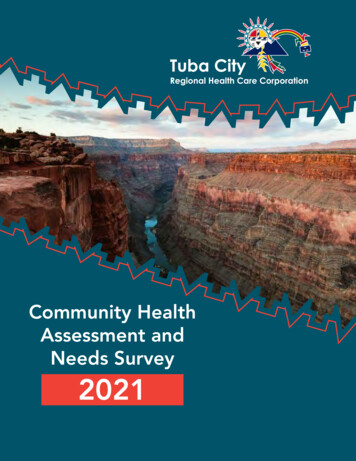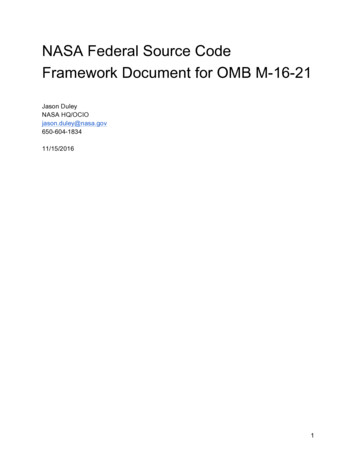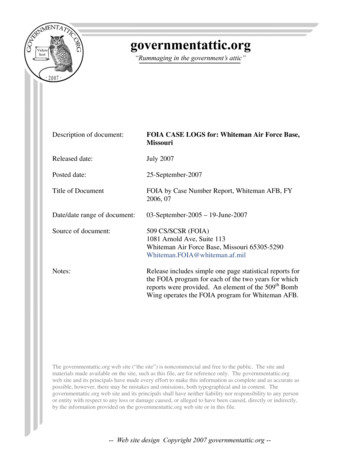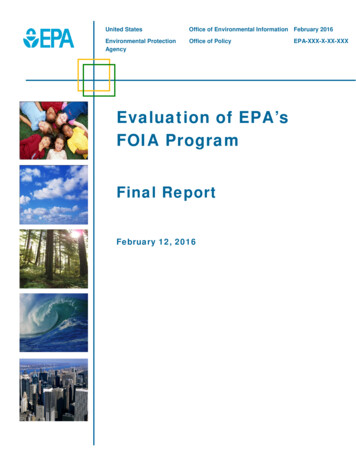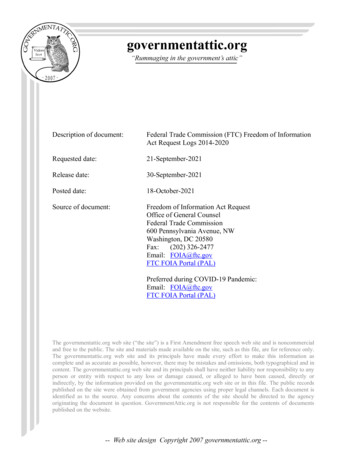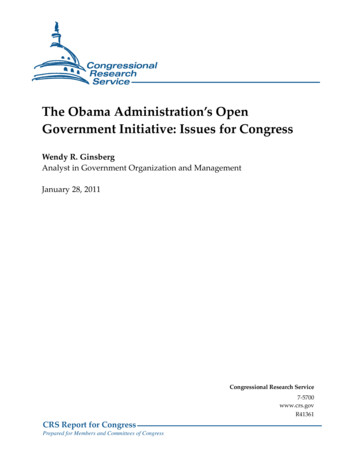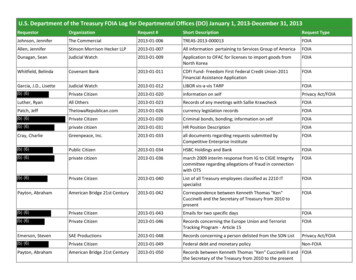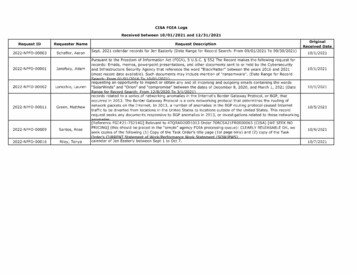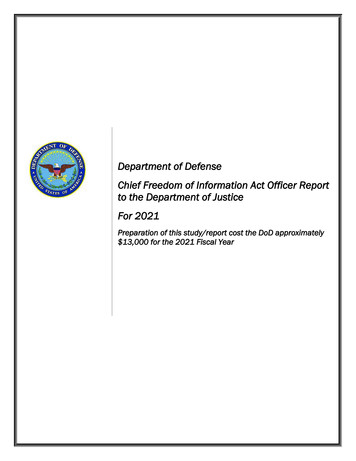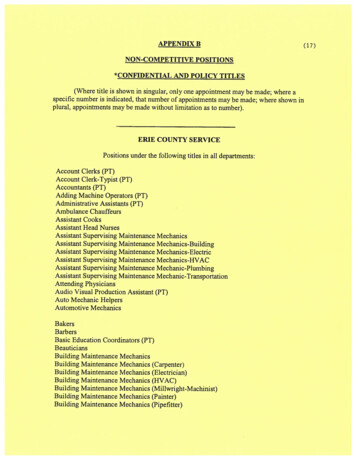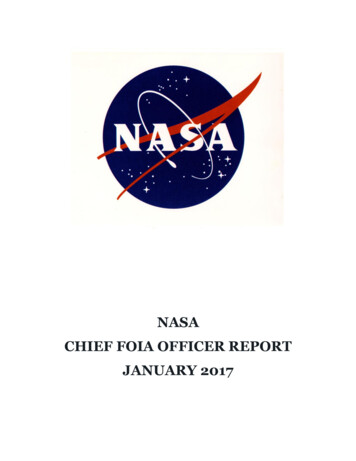
Transcription
NASACHIEF FOIA OFFICER REPORTJANUARY 2017
National Aeronautics and Space Administration2017 Chief FOIA Officer ReportNASA Chief FOIA OfficerRobert JacobsAssociate Administratorfor Communications, ActingSection 1: Steps Taken to Apply the Presumption of OpennessThe guiding principle underlying the President's FOIA Memorandum and the DOJ’s 2009 FOIAGuidelines is the presumption of openness.Please answer the following questions in order to describe the steps your agency has taken toensure that the presumption of openness is being applied to all decisions involving theFOIA. You may also include any additional information that illustrates how your agency isworking to apply the presumption of openness.A. FOIA Training1. Did your FOIA professionals or the personnel at your agency who have FOIA responsibilitiesattend any FOIA training or conference during the reporting period such as that provided by theDepartment of Justice?ANSWER: Yes2. If yes, please provide a brief description of the type of training attended and the topicscovered.ANSWER: FOIA Staff attend a monthly VITS for training. In October, FOIA staff attendingtraining in Washington, DC. Advanced FOIA training was covered, including recent changes inthe law, case-law, fees, and search issues.3. Provide an estimate of the percentage of your FOIA professionals and staff with FOIAresponsibilities who attended substantive FOIA training during this reporting period.ANSWER: 100%
4. OIP has directed agencies to “take steps to ensure that all of their FOIA professionals attendsubstantive FOIA training at least once throughout the year.” If your response to the previousquestion is that less than 80% of your FOIA professionals attended training, please explain youragency’s plan to ensure that all FOIA professionals receive or attend substantive FOIA trainingduring the next reporting year.ANSWER: 100% of our staff attended training either in-person or through the monthly VITS.B. Outreach5. OPTIONAL: Did your FOIA professionals engage in any outreach or dialogue with therequester community or open government groups regarding your administration of the FOIA?ANSWER: Yes. When appropriate, FOIA staff contact the requester/organization and explainthe agency search capabilities as well as the requirement to maintain records.C. Other Initiatives6. Describe any efforts your agency has undertaken to inform non-FOIA professionals of theirobligations under the FOIA?ANSWER: FOIA Staff are providing overview training to other staff throughout the Agency.7. If there are any other initiatives undertaken by your agency to ensure that the presumption ofopenness is being applied, please describe them here.ANSWER:NASA continues to have one of the top rated websites in the Federal Government dueto the frequent updating of information that is of interest to the public. NASA also has multipleavenues for the public to acquire information of interest, which has helped to reduce the need tosubmit a FOIA request to the Agency.Section II: Steps Taken to Ensure that Your Agency Has an Effective System in Place forResponding to RequestsThe DOJ’s 2009 FOIA Guidelines emphasized that "[a]pplication of the proper disclosurestandard is only one part of ensuring transparency. Open government requires not just apresumption of disclosure, but also an effective system for responding to FOIA requests." It isessential that agencies effectively manage their FOIA program.Please answer the following questions to describe the steps your agency has taken to ensure thatthe management of your FOIA program is effective and efficient. You should also include anyadditional information that that describes your agency's efforts in this area.
A. Processing Procedures1. For Fiscal Year 2016, what was the average number of days your agency reported foradjudicating requests for expedited processing? Please see Section VIII.A. of your agency'sFiscal Year 2016 Annual FOIA Report.ANSWER: 2.82 days2. If your agency's average number of days to adjudicate requests for expedited processing wasabove ten calendar days, please describe the steps your agency will take to ensure that requestsfor expedited processing are adjudicated within ten calendar days or less.ANSWER: N/A3. OPTIONAL: During the reporting period, did your agency conduct a self-assessment of itsFOIA program? If so, please describe the methods used, such as reviewing Annual Report data,using active workflows and track management, reviewing and updating processing procedures,etc.ANSWER: Yes. On a regular basis, reviewing caseload, procedures, etc. When a FOIA Officebegan incurring a heavy caseload, the staff worked across the Agency to provide assistance whenpossible.4. Please provide an estimate of how many requests your agency processed in Fiscal Year 2016that were from commercial use requesters. If your agency is decentralized, please identify anycomponents within your agency that received a majority of their requests from commercial userequesters.ANSWER: 333 requests or roughly 39%. JSC received the majority.B. Requester Services5. OPTIONAL: Does your agency provide a mechanism for requesters to provide feedback abouttheir experience with the FOIA process at your agency? If so, please describe the methods used,such as making the FOIA Public Liaison available to receive feedback, using surveys posted onthe agency’s website, etc.ANSWER: Yes. Some Centers provide a feedback website.
6. The FOIA Improvement Act of 2016 requires additional notification to requesters about theservices provided by the agency’s FOIA Public Liaison. Please provide an estimate of how oftenrequesters sought assistance from your agency’s FOIA Public Liaison.ANSWER: Less than five times.7. The FOIA Improvement Act of 2016 requires agencies to make their reference material orguide for requesting records or information from the agency electronically available to thepublic. Please provide a link to your agency’s FOIA reference guide.ANSWER: https://www.nasa.gov/FOIA/guidance.htmlC. Other Initiatives8. If there are any other steps your agency has undertaken to ensure that your FOIA systemoperates efficiently and effectively, such as improving search processes, eliminating redundancy,etc., please describe them here.ANSWER: NASA continues to have one of the top rated websites in the Federal Governmentdue to the continual updates of information that is of interest to the public. NASA also hasmultiple avenues for the public to acquire information of interest, which has helped to reduce theneed to submit a FOIA request to the Agency.Section III: Steps Taken to Increase Proactive DisclosuresBoth the President’s and DOJ's FOIA memoranda focused on the need for agencies to workproactively to post information online without waiting for individual requests to be received.Please answer the following questions to describe the steps your agency has taken to increase theamount of material that is available on your agency websites. In addition to the questions below,you should also describe any additional steps taken by your agency to make and improveproactive disclosures of information.A. Posting Material1. Describe your agency’s process or system for identifying “frequently requested” records thatshould be posted online.ANSWER: NASA offices post material that is of current public interest on the FOIA andmission websites. Typically, FOIA offices post all contract documents that have been requestedunder the FOIA. In general, the FOIA offices post material that has been the subject of publicinterest or is anticipated to be of public interest regardless of the number of FOIA requests for
the documents. The FOIA offices also work with the mission/program offices to identifydocuments that should be posted on both websites.2. Does your agency have a distinct process or system in place to identify other records forproactive disclosure? If so, please describe your agency’s process or system.ANSWER: NASA offices post material that is of current public interest on the program andmission websites. Generally, the offices post as much as possible to provide the public withinformation and provide awareness of the Agency programs and initiatives. Public interest isdetermined by the program offices coupled with agency initiatives; NASA has very robustwebsites and public outreach programs.3. Has your agency encountered challenges that make it difficult to post records you otherwisewould like to post?ANSWER: Yes.4. If so, briefly explain those challenges and how your agency is working to overcome them.ANSWER: If records contain pictures or tables, the FOIA staff are not able to ensure they are508 compliant and the queue for obtaining 508 compliance is long. We are hoping there issoftware developed that helps process pictures and tables in a relatively easy format so the FOIAstaff can ensure compliance themselves.5. Provide examples of material that your agency has proactively disclosed during the pastreporting year, including links to the posted material.ANSWER: Documents related to the Presidential transition as well as travel information. Otherprogram offices post documents related to missions on their websites. The Office of theInspector General posts reviews, reports, report IA/err.htm6. Did your agency use any means to publicize or highlight important proactive disclosures forpublic awareness? If yes, please describe these efforts.ANSWER: Yes. Our program offices regularly post documents related to mission updates,launches, etc., and this information is further publicized through tweets, program-sponsoredevents. The Public Inquiries Office has revised their website to provide direct links to materialof interest to the public. For example, following the death of Astronaut John Glenn, NASAreceived thousands of inquiries asking about his life. The Public Inquiries Office published adirect link on their homepage to his bio and other information, thus reducing the number ofinquiries and providing the public with the information they sought.
B. Other Initiatives7. If there are any other steps your agency has taken to improve proactive disclosures, pleasedescribe them here. For example, has your agency engaged requesters in determining how andwhat to post? Has your agency used web analytics to inform your proactive disclosures?ANSWER: NASA uses webmetrics to determine what the public is seeking and then works withthe program offices to ensure information is posted about these topics.Section IV: Steps Taken to Greater Utilize TechnologyA key component of the President's FOIA Memorandum was the direction to "use moderntechnology to inform citizens about what is known and done by their Government." In additionto using the internet to make proactive disclosures, agencies should also be exploring ways toutilize technology in responding to requests.Please answer the following questions to describe how your agency is utilizing technology toimprove its FOIA administration and the public's access to information. You should also includeany additional information that that describes your agency's efforts in this area.A. Making Material Posted Online More Useful1. Beyond posting new material, is your agency taking steps to make the posted informationmore useful to the public, especially to the community of individuals who regularly access youragency’s website?ANSWER: Yes.2. If yes, please provide examples of such improvements.ANSWER: The websites are continually updated with the most current information as eventsoccur. The Public Inquiries site updates and posts links to information that is timely, forexample the John Glenn, Hidden Figures and Eugene Cernan information.B. Other Initiatives3. Did your agency successfully post all four quarterly reports for Fiscal Year 2016?ANSWER: Yes
4. If your agency did not successfully post all quarterly reports, with information appearing onFOIA.gov, please explain why and provide your agency’s plan for ensuring that such reporting issuccessful in Fiscal Year 2017.ANSWER: N/A, all reports were posted.Section V: Steps Taken to Improve Timeliness in Responding to Requests and ReducingBacklogsThe President’s FOIA Memorandum and the DOJ’s 2009 FOIA Guidelines have emphasized theimportance of improving timeliness in responding to requests. This section of your Chief FOIAOfficer Report addresses both time limits and backlog reduction. Backlog reduction is measuredboth in terms of numbers of backlogged requests or appeals and by looking at whether agenciesclosed their ten oldest requests, appeals, and consultations.For the figures required in this Section, please use the numbers contained in the specifiedsections of your agency’s 2016 Annual FOIA Report and, when applicable, your agency’s 2015Annual FOIA Report.A. Simple TrackSection VII.A of your agency’s Annual FOIA Report, entitled "FOIA Requests – Response Timefor All Processed Requests," includes figures that show your agency's average response times forprocessed requests. For agencies utilizing a multi-track system to process requests, there is acategory for "simple" requests, which are those requests that are placed in the agency’s fastest(non-expedited) track, based on the low volume and/or simplicity of the records requested.1. Does your agency utilize a separate track for simple requests?ANSWER: Yes2. If so, for your agency overall in Fiscal Year 2016, was the average number of days to processsimple requests twenty working days or fewer?ANSWER: YES3. Please provide the percentage of requests processed by your agency in Fiscal Year 2016 thatwere placed in your simple track.ANSWER: 61%
4. If your agency does not track simple requests separately, was the average number of days toprocess all non-expedited requests twenty working days or fewer?ANSWER: Yes. The Agency does track simple requests separately as well.B. BacklogsSection XII.A of your agency’s Annual FOIA Report, entitled "Backlogs of FOIA Requests andAdministrative Appeals" shows the numbers of any backlogged requests or appeals from thefiscal year. You should refer to these numbers from your Annual FOIA Reports for both FiscalYear 2015 and Fiscal Year 2016 when completing this section of your Chief FOIA OfficerReport.BACKLOGGED REQUESTS5. If your agency had a backlog of requests at the close of Fiscal Year 2016, did that backlogdecrease as compared with the backlog reported at the end of Fiscal Year 2015? If not, explainwhy and describe the causes that contributed to your agency not being able reduce its backlog.ANSWER: The backlog decreased.6. If not, explain why and describe the causes that contributed to your agency not being able toreduce its backlog. When doing so, please also indicate if any of the following were contributingfactors: An increase in the number of incoming requests.A loss of staff.An increase in the complexity of the requests received. If possible, please provideexamples or briefly describe the types of complex requests contributing to your backlogincrease.Any other reasons – please briefly describe or provide examples when possible.ANSWER: N/A, the backlog decreased.7. If you had a request backlog please report the percentage of requests that make up the backlogout of the total number of requests received by your agency in Fiscal Year 2016.ANSWER: .0008 percentBACKLOGGED APPEALS
8. If your agency had a backlog of appeals at the close of Fiscal Year 2016, did that backlogdecrease as compared with the backlog reported at the end of Fiscal Year 2015? If not, explainwhy and describe the causes that contributed to your agency not being able reduce backlog.ANSWER: Increased by 1. It was a very complex case.9. If not, explain why and describe the causes that contributed to your agency not being able toreduce its backlog. When doing so, please also indicate if any of the following were contributingfactors: An increase in the number of incoming appeals.A loss of staff.An increase in the complexity of the requests received. If possible, please provideexamples or briefly describe the types of complex requests contributing to your backlogincrease.Any other reasons – please briefly describe or provide examples when possible.ANSWER: It was a complex request and appeal. Some requests and associated appeals containa wide-variety of information that needs to be carefully considered for a final determination,including ITAR, submitter, critical information.10. If you had an appeal backlog please report the percentage of appeals that make up thebacklog out of the total number of appeals received by your agency in Fiscal Year 2016. If youragency did not receive any appeals in Fiscal Year 2016 and/or has no appeal backlog, pleaseanswer with "N/A."ANSWER: 15%C. Status of Ten Oldest Requests, Appeals, and ConsultationsSection VII.E, entitled "Pending Requests – Ten Oldest Pending Requests," Section VI.C.(5),entitled "Ten Oldest Pending Administrative Appeals," and Section XII.C., entitled"Consultations on FOIA Requests – Ten Oldest Consultations Received from Other Agenciesand Pending at Your Agency," show the ten oldest pending requests, appeals, andconsultations. You should refer to these numbers from your Annual FOIA Reports for bothFiscal Year 2015 and Fiscal Year 2016 when completing this section of your Chief FOIA OfficerReport.TEN OLDEST REQUESTS
11. In Fiscal Year 2016, did your agency close the ten oldest requests that were reported pendingin your Fiscal Year 2015 Annual FOIA Report?ANSWER: Yes12. If no, please provide the number of these requests your agency was able to close by the endof the fiscal year, as listed in Section VII.E of your Fiscal Year 2015 Annual FOIA Report. Ifyou had less than ten total oldest requests to close, please indicate that.ANSWER: N/A, all were closed.13. Of the requests your agency was able to close from your ten oldest, please indicate howmany of these were closed because the request was withdrawn by the requester. If any wereclosed because the request was withdrawn, did you provide any interim responses prior to thewithdrawal?ANSWER: None. All requests were processed.TEN OLDEST APPEALS14. In Fiscal Year 2016, did your agency close the ten oldest appeals that were reported pendingin your Fiscal Year 2015 Annual FOIA Report?ANSWER: YES15. If no, please provide the number of these appeals your agency was able to close by the end ofthe fiscal year, as listed in Section VII.C.(5) of your Fiscal Year 2015 Annual FOIA Report. Ifyou had less than ten total oldest appeals to close, please indicate that.ANSWER: N/A. all appeals were closed.TEN OLDEST CONSULTATIONS16. In Fiscal Year 2016, did your agency close the ten oldest consultations that were reportedpending in your Fiscal Year 2015 Annual FOIA Report?ANSWER: None were pending at and of FY 1517. If no, please provide the number of these consultations your agency was able to close by theend of the fiscal year, as listed in Section XII.C. of your Fiscal Year 2015 Annual FOIAReport. If you had less than ten total oldest consultations to close, please indicate that.
ANSWER: No consultations were pending at end of FY 15E. Additional Information on Ten Oldest Requests, Appeals, and Consultations & Plans18. Briefly explain any obstacles your agency faced in closing its ten oldest requests, appeals,and consultations from Fiscal Year 2015.ANSWER: We did not have any obstacles. Many of the requests and appeals received at NASAare very complex, requiring extensive program, attorney, ITAR review. This will increase thetimelines, but these are expected obstacles for the type of Agency information.19. If your agency was unable to close any of its ten oldest requests because you were waiting tohear back from other agencies on consultations you sent, please provide the date the request wasinitially received by your agency, the date when your agency sent the consultation, and the datewhen you last contacted the agency where the consultation was pending.ANSWER: NASA closed all oldest cases.20. If your agency did not close its ten oldest pending requests, appeals, or consultations, pleaseprovide a plan describing how your agency intends to close those “ten oldest” requests, appeals,and consultations during Fiscal Year 2017.ANSWER: NASA closed all outstanding requests, appeals and consultations.F. Success StoriesOPTIONAL: Out of all the activities undertaken by your agency since March 2016 to increasetransparency and improve FOIA administration, please briefly describe here at least one successstory that you would like to highlight as emblematic of your agency’s efforts. The success storycan come from any one of the five key areas. As noted above, these agency success stories willbe highlighted during Sunshine Week by OIP. To facilitate this process, all agencies should usebullets to describe their success story and limit their text to a half page. The success story isdesigned to be a quick summary of key achievements. A complete description of all your effortswill be contained in the body of your Chief FOIA Officer Report.ANSWER: This year the NASA FOIA program has undergone a very thorough review of itsbusiness processes. The Headquarters FOIA Office has a dedicated FOIA Officer processing therequests received by the Centers that have few requests, thus shifting the workload and expertiserequirements to a full-time FOIA Officer. NASA has a very limited full-time FOIA staff, whichis a problem when the offices receive very complex requests (some have over 10,000 pages). Inorder to ensure we maintain a constant flow of requests/responses, the FOIA staff work togetherhelping each other out with redactions, letters, etc. This has been extremely beneficial across theboard and ultimately helped to keep the backlog at a minimum. The NASA FOIA Program is no
longer Center-specific, but all the FOIA staff are taking ownership for the Agency program,which is a tremendous benefit to the staff as well as the Agency.
ANSWER: NASA uses webmetrics to determine what the public is seeking and then works with the program offices to ensure information is posted about these topics. Section IV: Steps Taken to Greater Utilize Technology A key component of the President's FOIA Memorandum was the direction to "use modern

